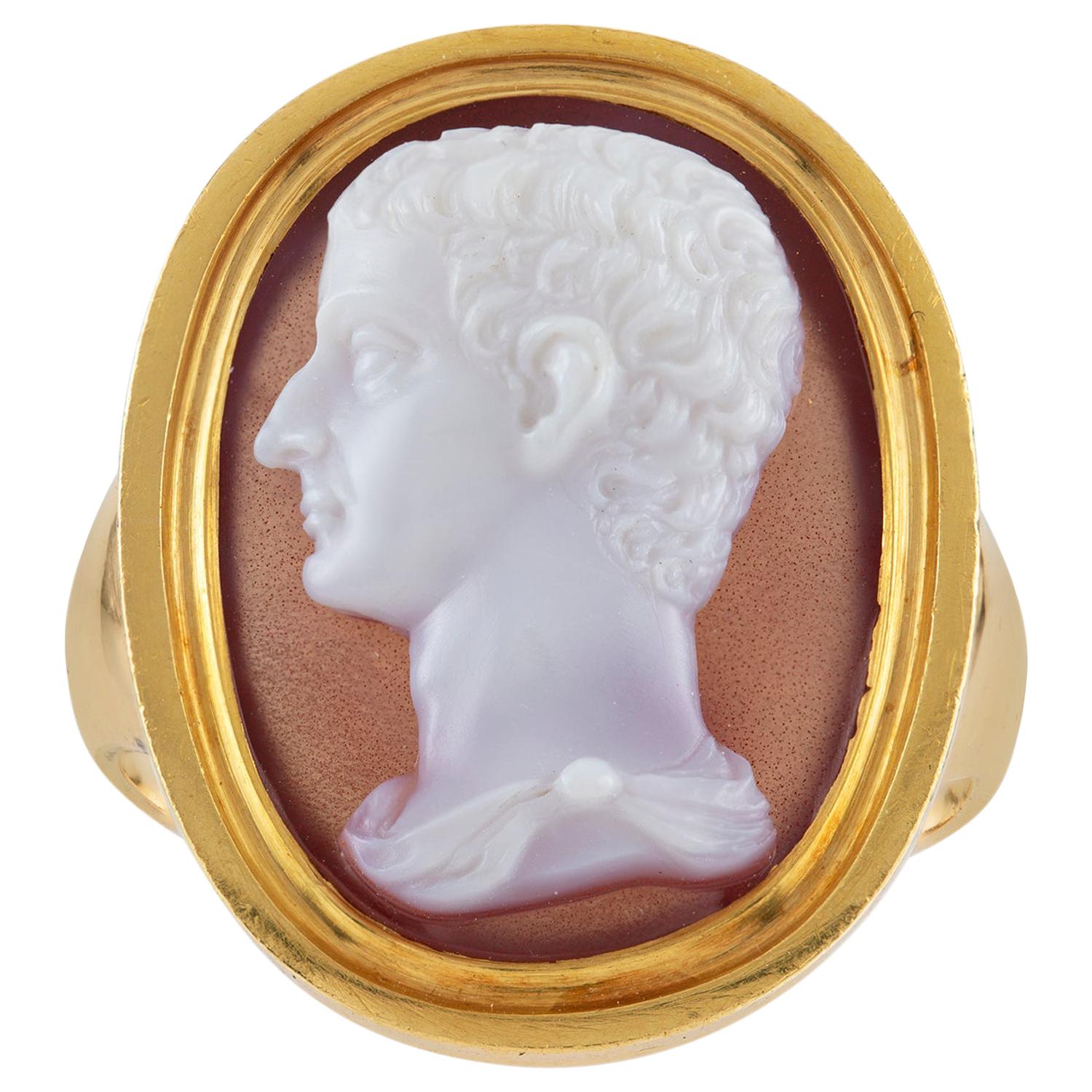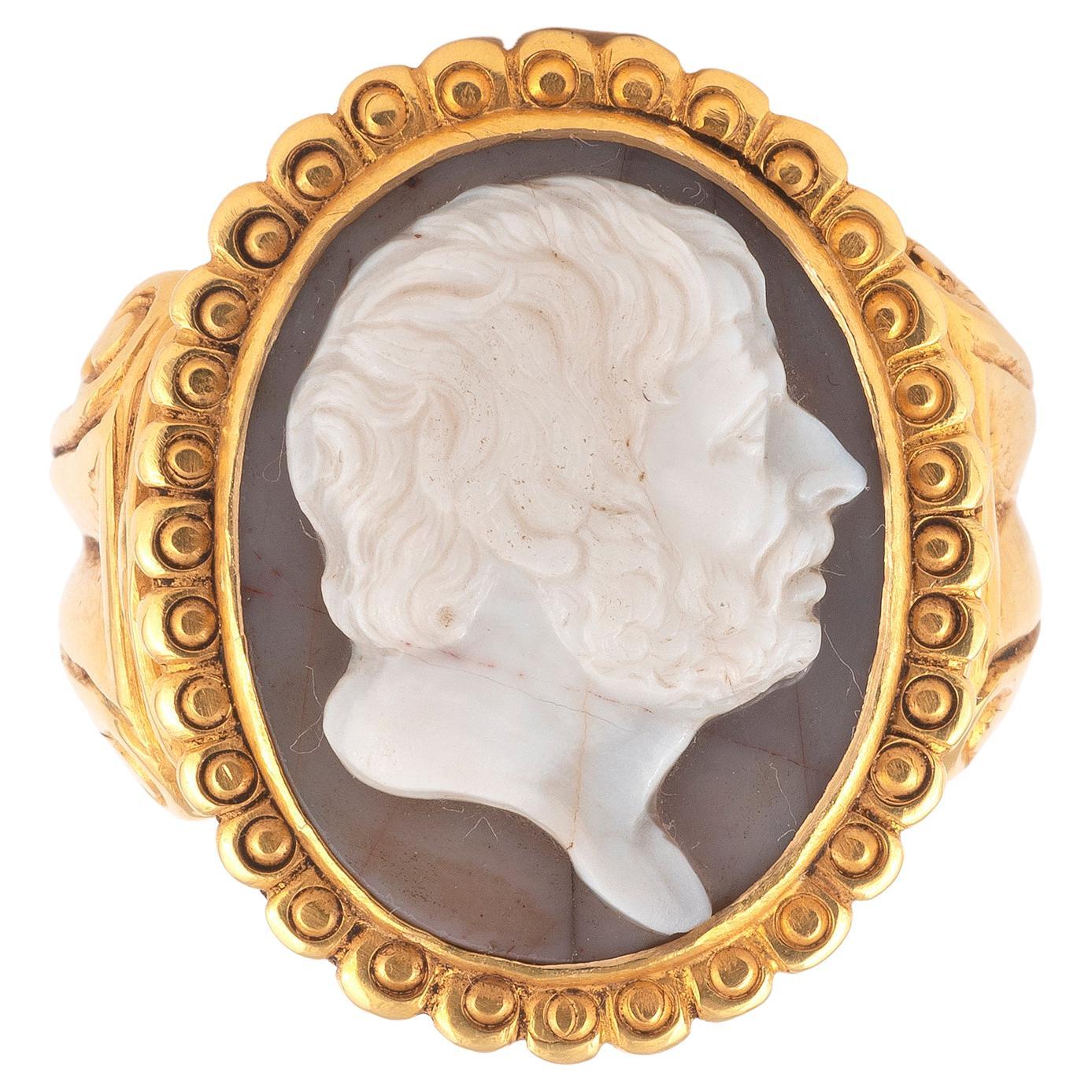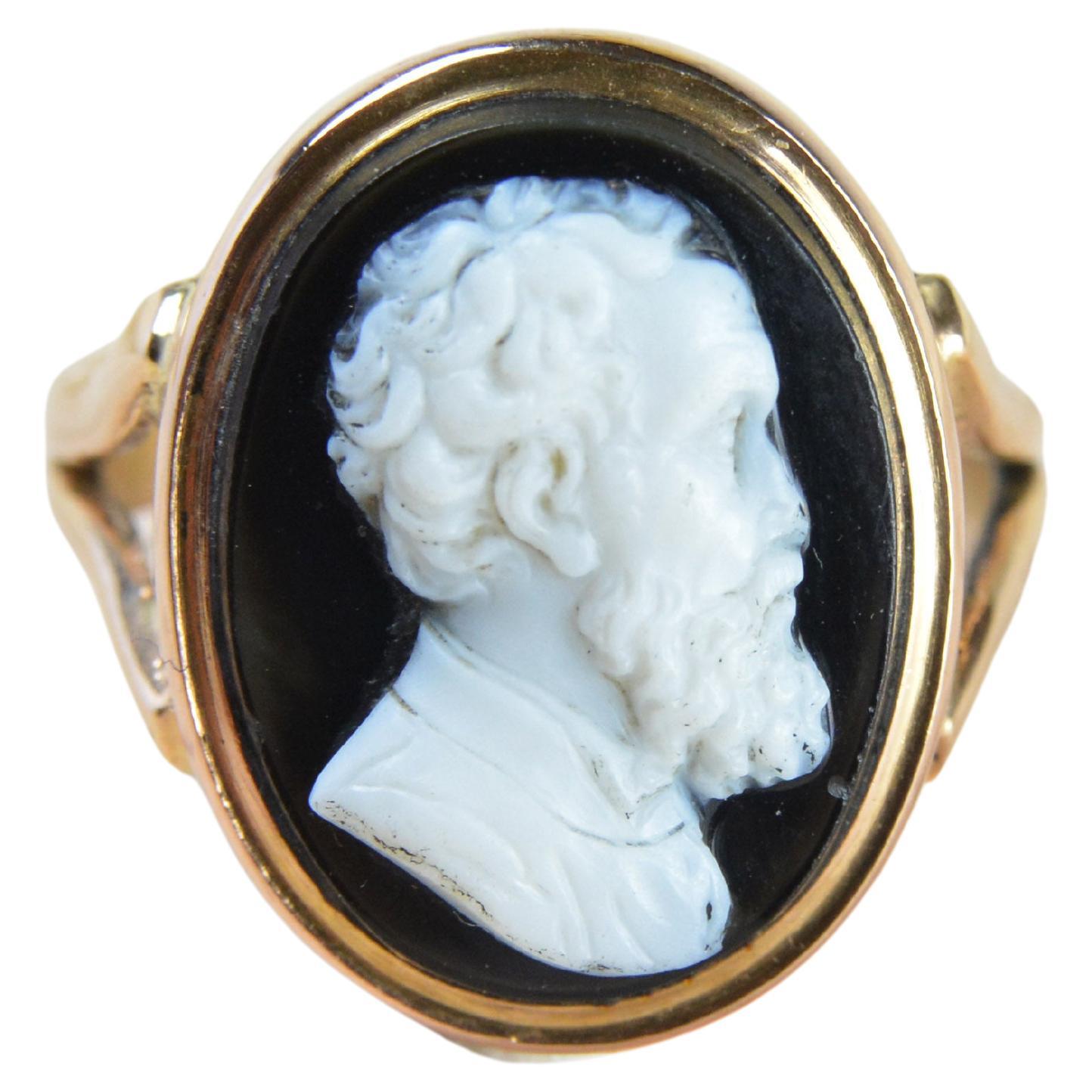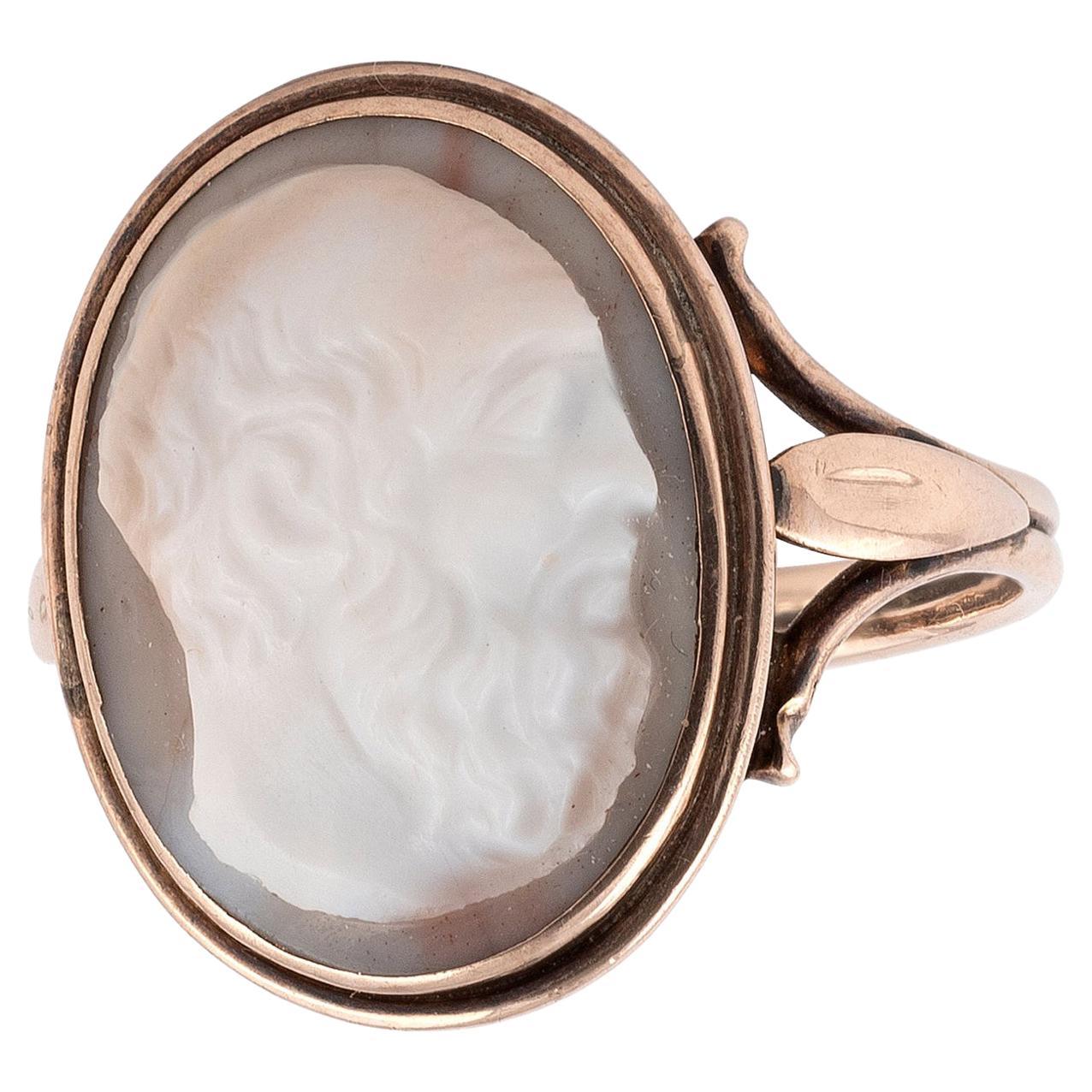Items Similar to Antique Italian 18th Century Georgian Gold Cameo Ring Bust of Medusa Hardstone
Video Loading
Want more images or videos?
Request additional images or videos from the seller
1 of 18
Antique Italian 18th Century Georgian Gold Cameo Ring Bust of Medusa Hardstone
About the Item
A gorgeous 18th century Italian hardstone cameo ring. This beautiful four layered sardonyx cameo is carved from a single piece of agate with immense skill to reveal the bust of the Gorgon Medusa in classical style. Classical and Hellenistic depictions of Medusa are much more human than the ones we may know today with her sharp teeth and gaping mouth. These classical depictions, although much less monstrous, still retain a sense of the supernatural with subtle details such as a winged head and long snake-like hair. Message for examples of 18th century copperplate engravings of Medusa cameo carvings from notable collections.
The master carver cleverly uses each of the stone’s four differently coloured layers to fill various parts of the portrait. The topmost, a bright orange layer with red splatters, is used for the sinuous red hair which drapes down the shoulders. A lighter and more opaque white layer is carved underneath which softly frames the face. The background is a highly unusual yet beautifully contrasting blue colour whilst the final layer, a deep black, is only visible on the underside of the ring. The mount is crafted in 21K gold and is of typical late 18th century Georgian form.
UK size M 1/2, US size 6.5
The ring weighs 4.79g and the gold tests as 21K.
The oval face measures 22mm x 17mm.
Similar examples can be found in The British Museum (no. 1867,0507.706) as well as in The Royal Collection Trust (inventory no. RCIN: 65183, 65181, 65194). Message for photos of these examples.
- Ring Size:6.5 US, Resizable
- Metal:
- Stone:
- Stone Cut:
- Weight:4.79 g
- Style:
- Place of Origin:
- Period:
- Date of Manufacture:1780
- Condition:
- Seller Location:London, GB
- Reference Number:1stDibs: LU2845219613132
Resizing is available.
About the Seller
5.0
Vetted Seller
These experienced sellers undergo a comprehensive evaluation by our team of in-house experts.
Established in 2019
1stDibs seller since 2022
32 sales on 1stDibs
Typical response time: 11 hours
- ShippingRetrieving quote...Ships From: London, United Kingdom
- Return PolicyA return for this item may be initiated within 14 days of delivery.
More From This SellerView All
- Antique Gold Cameo Ring Greek Theatre Mask Silenus Hardstone Intaglio SignetLocated in London, GBA very unusual antique gold ring set with a carved brown and white hardstone cameo depicting the theatrical comic mask of Silenus, the Greek mythological old rustic god of wine-making and drunkenness. The ring was made in the late 19th century and carries French control marks for 18K gold, whilst the cameo is probably Italian and made slightly earlier, circa 1800. Silenus was a companion to the wine god Dionysus, and suitably he was a notorious consumer of wine, usually drunk and supported by satyrs or carried by a donkey. Silenus was described as the oldest, wisest and most drunken of the followers of Dionysus, and was said to possess special knowledge and the power of prophecy when intoxicated. He presides over the other satyrs and is related to musical creativity, prophetic ecstasy, drunken joy and drunken dances. Silenus was usually depicted as a jovial old man, bald yet bearded, with a pot-belly, thick lips and snub-nose. The masks worn to play him in theatre really emphasised these features, as you can see with this cameo carving Theatre was a key part of ancient Greek culture. The theatrical masks worn by the actors, known as ‘prosopon’, served various purposes. They enabled individual actors to play multiple roles (or genders) in the same performance; the exaggerated expressions helped define the character being portrayed; they helped spectators in the back rows to tell the characters apart. This particular masked as mentioned before is a comedic Silenus, please see final photo for other examples of Silenus masks in museum collections. UK size N 1/2, US size 7 4.84g 18K gold French ‘tête...Category
Antique Early 19th Century Italian Georgian Signet Rings
MaterialsAgate, 18k Gold
- Georgian 18th Century Signet Ring with Ancient Roman Nicolo Intaglio of HerculesLocated in London, GBA superb ancient Roman nicolo intaglio set in a late 18th century gold signet ring. Nicolo intaglios are a particular type of intaglio ma...Category
Antique Late 18th Century English Georgian Signet Rings
- Scarce Antique 18th Century Mughal 5ct Colombian Emerald Gold Ring CertifiedLocated in London, GBA scarce late 18th century high-karat gold and emerald ring, circa 1780. This superb gold ring is set with a large faceted natural emerald gemstone, approximately 5cts in weight. T...Category
Antique Late 18th Century Unknown Georgian Signet Rings
MaterialsEmerald, Gold
- Georgian Gold and Carnelian Signet Ring Large 19th Century Antique Seal RingLocated in London, GBA large antique English Georgian era gentleman’s gold signet ring, circa 1830. In the centre there is a flat-cut and bezel-set octagonal carneli...Category
Antique Early 19th Century British Georgian Signet Rings
MaterialsCarnelian, Gold
- 18th Century Gold Portrait Miniature Ring Shepherd Boy King David Painted EnamelLocated in London, GBThis rare antique late 18th century gold ring was made in France and features a painted enamel miniature of a shepherd boy holding a crook. This pastoral scene probably depicts David...Category
Antique Late 18th Century French Rococo Signet Rings
MaterialsGold, Enamel
- Rare Ancient Egyptian Carved Carnelian Frog Amulet Swivel Ring 18th DynastyLocated in London, GBThis rare Egyptian carved carnelian frog amulet dates to the Eighteenth Dynasty of the New Kingdom, circa 1300 BC. Frog amulets, depicting the goddess Heket, were commonly worn by both the living as a fertility charm and the dead to provide rejuvenation and a long afterlife. The ancient amulet is pierced horizontally and set into a later gold swivel mount, probably dating from the late 19th century. The design of the gold mount inspired by rings worn by the ancient Egyptians and Etruscans with its swivel bezel and coiled wire on the shoulders. The immense number of offspring made the frog an important symbol of fertility in ancient Egypt, and carved frog amulets were worn by women hoping for an easy delivery. This is exemplified with the goddess and protector of birth, Keket, who was depicted as a frog. After death, frog amulets would be placed within the wrappings of mummies, both men and women, in hope of a successful rebirth in the afterlife. The association between this amphibian and rebirth may have been induced by the fact that every year, millions of frogs spontaneously appeared out of the river mud and filled the fields after the annual inundation of the Nile. This caused the Egyptians to believe that they spontaneously generated themselves out of the river mud. The influence of frogs in Ancient Egypt can be seen in the language, the hieroglyphic sign for "one hundred thousand" was a tadpole, and one of the Egyptian terms denoting "frogs" is whm-anx, meaning literally "they who repeat life." Similar examples of ancient Egyptian carved...Category
Antique 15th Century and Earlier Signet Rings
MaterialsCarnelian, 22k Gold
You May Also Like
- Georgian Hardstone Cameo RingLocated in London, GBA Georgian hardstone cameo ring, the oval-shaped cameo depicting the profile of a patrician, rub-over set within a yellow gold mount with ridged d...Category
Antique 1820s British George III Fashion Rings
MaterialsAgate, 18k Gold
- Hardstone Cameo of a Man, 18th-19th CenturyLocated in Firenze, ITThe classical head facing left, clean shaven with short curling hair, in a later ring mount, ring size 8, length 30mm, width 20mm Weight : 29,4grCategory
Antique 1790s Italian Georgian Signet Rings
MaterialsAgate, 18k Gold, Yellow Gold
- Hardstone Cameo of Seneca 18th-19th CenturyLocated in Firenze, ITThe portrait head of Seneca, in a later ring mount, ring size 11 , length 27mm, width mm22 Weight:26.4gr.Category
Antique Late 18th Century Italian Neoclassical Signet Rings
Materials18k Gold, Yellow Gold
- Hardstone Cameo of a Man Ring 19th CenturyLocated in Firenze, ITThe portrait head, facing right, with short hair and clean shaven, in a later ring mount, ring size 8 length 29mm, width 16mmCategory
Antique 19th Century Italian Signet Rings
MaterialsAgate, 18k Gold, Yellow Gold
- Antique Georgian Hardstone Cameo Signet Ring, Greek Philosopher, 9ct Rose GoldLocated in Shepton Mallet, GBAn extremely well carved agate Cameo depicting a Classical Greek Philosopher, originally crafted in the late Georgian Era, set in 9ct Rose Gold. The agate Cameo consist of two different coloured strata of stone the top white layer is carved and reveals the black colour agate underneath. ~Details~ ERA:Late Georgian 1830...Category
Antique 1830s European Georgian Signet Rings
MaterialsAgate, Rose Gold
- Gold and Hardstone Cameo RingLocated in Firenze, ITCameo dipicting bearded man in agate mounted in gold. Size: 7 Weight: 3,9gr.Category
Antique 1890s Italian Victorian Signet Rings
MaterialsGold
Recently Viewed
View AllMore Ways To Browse
Cite Cavaliere
Pegasus Signet Ring
Signet Ring With Key
Swivel Scarab Rings
Tiffany College Ring
Vintage Gold Masonic Rings
Vintage Mercury Ring
19k Signet Ring
Demeter Ring
Dog Cameo Ring
Enemal Ring
Signet Fob
Hermes Miniature Set
Intaglios Owl
Mens Cameo Rings Vintage
Mens Moonstone Ring
Oval Signet Ring Tiffany
Scarab Intaglio





